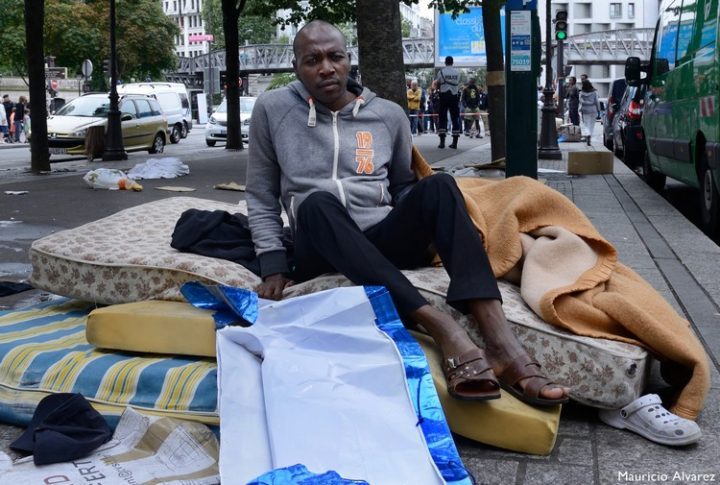By Baher Kamal
Every single day, print and online media and TV broadcasters show images and footage of migrants and refugees adrift, salvage teams rescuing their corpses–alive or dead, from fragile boats that are often deliberately sunk by human traffickers near the coasts of a given country. Their dramas are counted –and told– quasi exclusively in cold figures.
Every now and then a reporter talks to a couple of them or interviews some of the tens of humanitarian organisations and groups, mostly to get information about their life conditions in the numerous so called “reception centres” that are often considered rather as “detention centres” installed on both shores of the Mediterranean sea.
It is a fact that their numbers are shocking: 101,417 migrants and refugees entered Europe by sea in 2017 through 9 July, the UN International Organization for Migration (IOM) has reported. Of this total, 2,353 died.
Beyond the figures, migrants and refugees live inhumane drama, are victims of rights abuse, discrimination, xenophobia and hatred–often encouraged by some politicians. Let alone that tragic realty that they fall easy pry to human traffickers who handle them as mere merchandise. See: African Migrants Bought and Sold Openly in ‘Slave Markets’ in Libya..
On top of that, another UN organisation—the UN Children’s Fund (UNICEF) reports that the Central Mediterranean from North Africa to Europe is among the world’s deadliest and most dangerous migrant routes for children and women.
“The route is mostly controlled by smugglers, traffickers and other people seeking to prey upon desperate children and women who are simply seeking refuge or a better life,” it reports. See: A Grisly Tale of Children Falling Easy Prey to Ruthless Smugglers.
On this, Afshan Khan, UNICEF Regional Director and Special Coordinator for the Refugee and Migrant Crisis in Europe, said that this route “is mostly controlled by smugglers, traffickers and other people seeking to prey upon desperate children and women who are simply seeking refuge or a better life.”
Moreover, the United Nations Office on Drugs and Crime (UNODC) has estimated that 7 of 10 victims of human traffickers are women and children.
True that statistics help evaluate the magnitude of such an inhumane drama. But, is this enough?
1,200 Migrants Tell Their Dreams and Realities
In a singular initiative, IOM launched “i am a migrant” – a platform to promote diversity and inclusion of migrants in society.
It’s specifically designed to support volunteer groups, local authorities, companies, associations, groups, indeed, anyone of goodwill who is concerned about the hostile public discourse against migrants, says IOM.
“i am a migrant” allows the voices of individuals to shine through and provides an honest insight into the triumphs and tribulations of migrants of all backgrounds and at all phases of their migratory journeys.”
“While we aim to promote positive perceptions of migrants we do not shy away from presenting life as it is experienced. We seek to combat xenophobia and discrimination at a time when so many are exposed to negative narratives about migration – whether on our social media feeds or on the airwaves.”
The IOM campaign uses the testimonials of migrants to connect people with the human stories of migration. Thus far, it has seen 1,200 profiles published. The anecdotes and memories shared on the platform help us understand what words such as “integration”, “multiculturalism” and “diversity” truly mean.
Through stories collected by IOM teams around the world, “diversity finally finds a human face.” While inviting migrants to share their stories with its teams, IOM informs that “i am a migrant” is part of the UN TOGETHER initiative that promotes respect, safety and dignity for everyone who has left home in search of a better life.
From the Ashes of World War II
IOM is among the world’s most experienced international agencies dealing with migrants. No wonder– it rose from the ashes of World War Two over 65 years ago.
“In the battle-scarred continent of Europe, no government alone could help survivors who wanted no more than an opportunity to resume their lives in freedom and with dignity. The first incarnation of IOM was created to resettle refugees during this post-war period,” it reminds.
The agency’s history tracks the man-made and natural disasters of the past over 65 years – Hungary 1956; Czechoslovakia 1968; Chile 1973; the Viet Nam boat people 1975; Kuwait 1990, Kosovo and Timor 1999; the 2003 invasion of Iraq; the 2004 Asian tsunami, the 2005 Pakistan earthquake and Haiti’s 2010 earthquake.
Now under the United Nations umbrella as part of its system since 2016, IOM quickly grew from a focus on migrant and refugee resettlement to become the world’s leading inter-governmental organisation dedicated to the well-being, safety and engagement of migrants.
Over the years, IOM has grown into 166 member states. Its global presence has expanded to over 400 field locations. With over 90 per cent of its staff deployed in the field, it has become a lead responder to the world’s worst humanitarian emergencies.
Shall these facts –and the stories migrants tell—help awaken the consciousness of those European politicians who ignore the fact that their peoples were once migrants and refugees as a consequences of wars their predecessors provoked? And that the migration agency was born for them?










